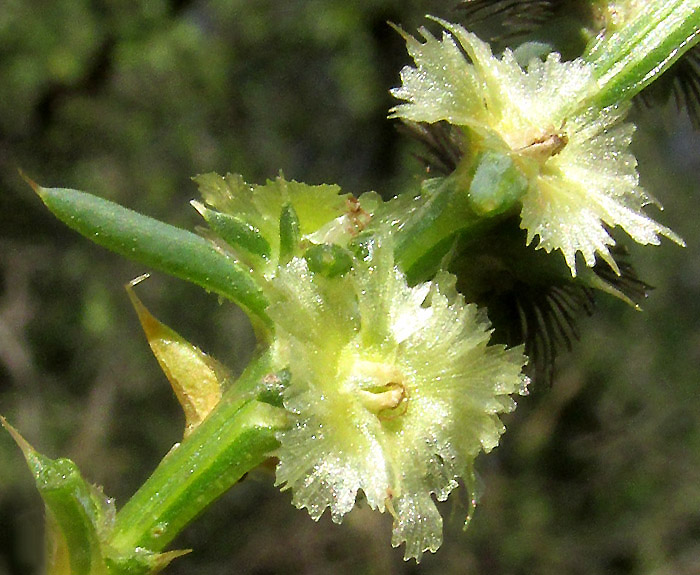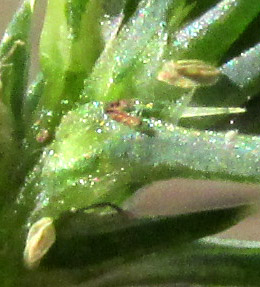Excerpts from Jim Conrad's
Naturalist Newsletter
Entry dated January 25, 2024, issued from near Tequisquiapan; elevation about 1,900m, (6200 ft), ~N20.57°, ~W99.89°; Querétaro state, MÉXICO
PRICKLY RUSSIAN THISTLE
 Beside a trail through the scrub, not far from a field of Alfalfa, the weed shown at the right was in full fruit. We're experiencing an ongoing, two-year long drought described by the North American Drought Monitor as a D3 Extreme Drought; with its lower leaves and branches turning brown and dying, the plant showed that it was stressed.
Beside a trail through the scrub, not far from a field of Alfalfa, the weed shown at the right was in full fruit. We're experiencing an ongoing, two-year long drought described by the North American Drought Monitor as a D3 Extreme Drought; with its lower leaves and branches turning brown and dying, the plant showed that it was stressed.
However, dying back in this manner may have been one of this species' adaptations evolved to deal with erratically occurring droughts. It was directing enough resources to its upper flowering part to be producing a healthy crop of fruits, as shown below:

At the left, the pea-size, white, starlike items are developing fruits. They appear among short, spine-like leaves and one wonders what kind of inflorescence is represented here. Many plant families produce flowers in only one or a few inflorescence types, so for identification the question is more than an idle one.
For this species, instead of naming a particular inflorescence type, such as panicle, raceme or spike, the online Flora of North America describes it as "... interrupted at maturity (at least proximally), 1-flowered (rarely 2-3-flowered with lateral flowers mostly abortive)." The term "proximally" means "near the place of attachment." This is an unusual flowering pattern, and with such flexibility in flower number, and with abortive flowering part of the equation, one suspects that this also is an adaptation for climates with unpredictable droughts.

As seen above, the plant's utricle-type fruits -- fruits with bladder-like structures surrounding the seed or seeds -- were remarkable. The silvery, starburst structures were modified perianths, the term perianth referring to a flower's combined calyx and corolla. Note that in each perianth's center there's a hole out of which pokes the fingerlike style of the ovary or developing fruit at the hole's bottom. Atop each style arise three brown, threadlike, shriveled stigmas about to drop off. Also notice the spine-tipped, succulent, water-preserving leaves. When the fruits are mature, they turn black and dry; one is seen behind the top flower.

Most plants in this population showed no signs of stamens. However, eventually the ones at the right were found on a young plant just beginning to flower. The yellowish-white, rice-grain-shaped items are anthers attached to very slender, black filaments. In this genus, each flower is supposed to produce five stamens, but I found only a few flowers with stamens, and each of those blossoms bore only a single stamen. This suggests that stamens shed their pollen and fall away after a brief appearance. Here's a look at the slender, stiff, spine-tipped leaves at the plant's base:

Identifying this species from the beginning might have been hard, but this is a famous plant known by many people who travel in somewhat dry, disturbed places. At least in North America, it's the most common and most conspicuous of several species known as tumbleweeds. Distinguishing this species from other tumbleweeds, often it's called the Prickly Russian Thistle. Currently Kew's Plants of the World Online database lists it as SALSOLA TRAGUS.
Our pictures portray young Prickly Russian Thistles. Adult plants become densely branched, grow to about waist high and can spread out over a meter wide. Our young plants, despite their spines, are edible to most wildlife and livestock, but when the plants mature they dry up, turn brown, and the branches arc upward, forming a roughly spherical shape. Older plants aren't eaten.
Once the plant is dried out, it may break from its base, which enables wind to tumble it across flat landscapes, mount up against fences and buildings, blow across highways, and all the rest. The idea is for the plant to disseminate its seeds, which can number as many as 200,000 per plant. If seeds land in a moist spot, they can quickly germinate into new plants, and if the soil is salty, they can deal with it. In the brave new world climate change is bestowing us, this species is poised to spread where it hasn't already gone.
Prickly Russian Thistles are native to Eurasia, but have become invasive over much of North America and Mexico, as well as Australia. It occurs spottily, so far, in South America and Africa.
Its exceeding adaptability and flexibility accounts largely for the remarkable mess of its taxonomy. Certain experts name it Kali tragus, and there's uncertainty whether to assign it to the Amaranth Family or the Goosefoot Family, the latter family often lumped into the Amaranth Family. Kew lists 25 synonyms for the species. Subspecies have been recognized but, as the Flora of North America says, both subspecies often are represented by intermediate or deviant forms.
Maybe Prickly Russian Thistles are trying to teach us something: Be flexible, adaptive, even prickly, and don't let anybody think they can pigeonhole you.